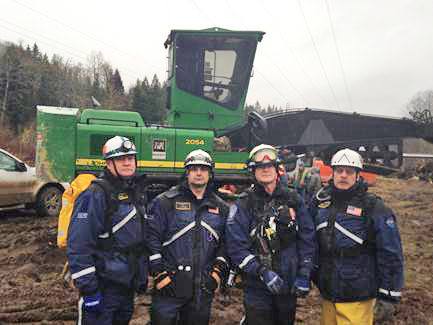On March 24th at 3 pm Valley Regional Fire Authority Battalion Chief Parry Boogard attended a meeting of the FEMA Urban Search and Rescue Washington State Task Force 1 (WA-TF1) Exercise Planning Committee.
The committee, with several leaders from WA-TFI, was in the process of finalizing the team’s Incident Action Plan in preparation of participation in the upcoming Alaska Shield 2014 Training Exercise in Anchorage Alaska.
During the course of the meeting, WA -TF1 Program Manager Mike McCaffree stepped in, alerting the planning group to a change of assignment.
Snohomish County Emergency Management was requesting the Urban Search & Rescue Team to support the rescue & recovery efforts at the Oso landslide disaster which occurred a few days prior.
The Valley Regional Fire Authority previously authorized the deployment of their four WA-TF1 USAR team members to support the Alaska Shield exercise. All of the personnel assigned to the exercise were packed and prepared for deployment.
The decision was made by WA-TF1 leadership to use these personnel for the initial response to the Oso Disaster due to their current state of readiness. Because the deployment request for this resource was not due to a federal disaster declaration, each agency with personnel assigned to the deployment would need to sign an inter-governmental agreement allowing their personnel to participate on the promise that Snohomish County would pick up the expense. The VRFA quickly executed the agreement to support this urgent, local disaster need.
The four VRFA personnel that deployed on the mission were Battalion Chief Parry Boogard as a Search Team Manager; Firefighter Barry Rickert as Hazmat Manager and Captain Dale Laginess and Firefighter Jason Herman as Rescue Specialists.
The Urban Search & Rescue Team completed their preparations for deployment in Pierce County and late that evening they boarded busses for the drive to Darrington, Washington where the team would set up camp for their mission, which was expected to last seven to 14 days.
The team arrived at the Darrington Fairgrounds at 0400 hours, the team immediately started the process to set up camp as the base of operations for the coming weeks.
While this was in process, a second group of team members were loading a box truck with the rescue tools, supplies and equipment that would be required to sustain the team in their daily search & rescue operations.
The weather that morning was just above freezing with steady wind and rain but spirits of the team and the community were high.
The first 12-hour operational period for the team started on March 25th at 0700 hours. The team was briefed and assigned to start their search and rescue mission on the east side of the landslide area.
The team was met with access limitations into the impacted areas due to significant amounts of water and mud mixed with debris piles of logs, brush, structural components of homes, personal items, vehicles, motorhomes and boats.
The entire lowland area had been inundated by a flow of clay-like mud that was 5- to 30-feet deep in some areas.
Each day of the deployment the team started with their morning briefing, identifying the area that search resources would be assigned to, and a safety briefing that identified the specific hazards and procedures that were in place to ensure that searchers were as safe as possible.
As the debris flow delayering process progressed, search dog handlers and their canine searchers evaluated the areas of probability for the “possible rescue or recovery of victims”. Search grids were established and mapped to support the rescue and recovery efforts. Hand held GPS units were used to verify and track all of the areas that were searched.
Areas of interest identified by the search dogs were prioritized to be systematically sorted through in an attempt to locate victims and human remains.
Each day WA TF-1 USAR personnel worked closely with community members, local volunteers and other emergency response personnel who were assisting on scene, WA-TF1 personnel also provided support to the heavy equipment operators, sawyers and loggers that were assisting with the rescue & recovery efforts.
The First Rotation of WA-TF1 USAR responders was demobilized on the morning of April 25 after 12 days of operations, they were replaced by a new rotation of WA-TF1 rescue personnel as well as a second USAR Team (CA-TF7) from Sacramento California, that was requested by Washington State to assist with the efforts on the west side of the Incident.


